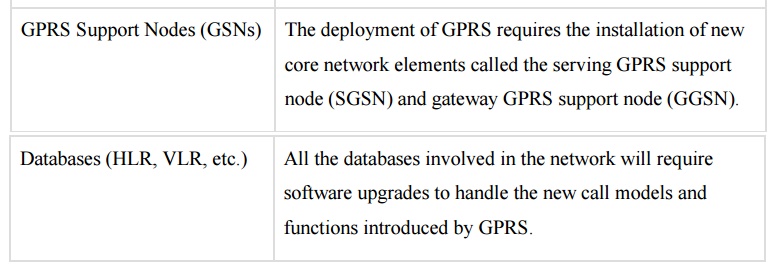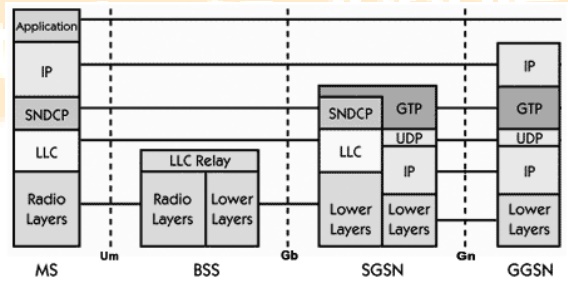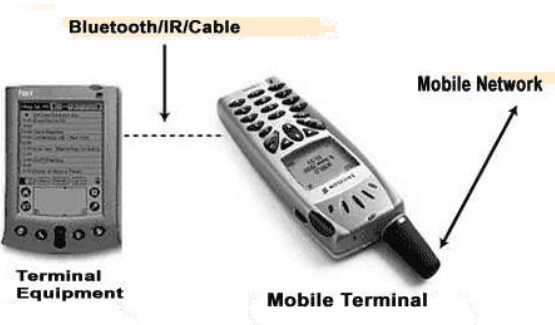Chapter: Mobile Computing : Mobile Telecommunication System
General Packet Radio Service
GENERAL PACKET RADIO SERVICE
General Packet Radio System is also
known as GPRS is a third-generation
step toward internet access. GPRS is
also known as GSM-IP that is a Global-System Mobile Communications Internet
Protocol as it keeps the users of this system online, allows to make voice
calls, and access internet on-the-go. Even Time-Division Multiple Access (TDMA)
users benefit from this system as it provides packet radio access.
GPRS also
permits the network operators to execute an Internet Protocol (IP) based core
architecture for integrated voice and data applications that will continue to
be used and expanded for 3G services.
GPRS
supersedes the wired connections, as this system has simplified access to the
packet data networks like the internet. The packet radio principle is employed
by GPRS to transport user data packets in a structure way between GSM mobile
stations and external packet data networks. These packets can be directly
routed to the packet switched networks from the GPRS mobile stations.
In the
current versions of GPRS, networks based on the Internet Protocol (IP) like the
global internet or private/corporate intranets and X.25 networks are supported.
Who owns GPRS ?
The GPRS
specifications are written by the European Telecommunications Standard
Institute (ETSI), the European counterpart of the American National Standard
Institute (ANSI).
Key Features
Following
three key features describe wireless packet data:
· The always online feature - Removes
the dial-up process, making applications only one click away.
· An upgrade to existing systems - Operators
do not have to replace their equipment; rather,
GPRS is added on top of the existing infrastructure.
· An integral part of future 3G systems - GPRS is
the packet data core network for 3G systems
EDGE and WCDMA.
Goals of GPRS
GPRS is
the first step toward an end-to-end wireless infrastructure and has the
following goals:
·
Open architecture
·
Consistent IP services
·
Same infrastructure for different air interfaces
·
Integrated telephony and Internet infrastructure
·
Leverage industry investment in IP
·
Service innovation independent of infrastructure
Benefits of GPRS
Higher Data Rate
GPRS
benefits the users in many ways, one of which is higher data rates in turn of
shorter access times. In the typical GSM mobile, setup alone is a lengthy
process and equally, rates for data permission are restrained to 9.6 kbit/s.
The session establishment time offered while GPRS is in practice is lower than
one second and ISDN-line data rates are up to many 10 kbit/s.
Easy Billing
GPRS
packet transmission offers a more user-friendly billing than that offered by circuit
switched services. In circuit switched services, billing is based on the
duration of the connection. This is unsuitable for applications with bursty
traffic. The user must pay for the entire airtime, even for idle periods when
no packets are sent (e.g., when the user reads a Web page).
In
contrast to this, with packet switched services, billing can be based on the
amount of transmitted data. The advantage for the user is that he or she can be
"online" over a long period of time but will be billed based on the
transmitted data volume.
GPRS Architecture
GPRS architecture works on the same procedure like
GSM network, but, has additional entities that allow packet data transmission.
This data network overlaps a second-generation GSM network providing packet
data transport at the rates from 9.6 to 171 kbps. Along with the packet data
transport the GSM network accommodates multiple users to share the same air
interface resources concurrently.
Following
is the GPRS Architecture diagram:

GPRS attempts to reuse the existing GSM network
elements as much as possible, but to effectively build a packet-based mobile
cellular network, some new network elements, interfaces, and protocols for
handling packet traffic are required.
Therefore,
GPRS requires modifications to numerous GSM network elements as summarized
below:


GPRS Mobile Stations
New Mobile Stations (MS) are required to use GPRS services because existing GSM phones do not handle the enhanced air interface or packet data. A variety of MS can exist, including a high-speed version of current phones to support high-speed data access, a new PDA device with an embedded GSM phone, and PC cards for laptop computers. These mobile stations are backward compatible for making voice calls using GSM.
GPRS Base Station
Subsystem
Each BSC requires the installation of one or more
Packet Control Units (PCUs) and a software upgrade. The PCU provides a physical
and logical data interface to the Base Station Subsystem (BSS) for packet data
traffic. The BTS can also require a software upgrade but typically does not
require hardware enhancements.
When either voice or data traffic is originated at
the subscriber mobile, it is transported over the air interface to the BTS, and
from the BTS to the BSC in the same way as a standard GSM call. However, at the
output of the BSC, the traffic is separated; voice is sent to the Mobile
Switching Center (MSC) per standard GSM, and data is sent to a new device
called the SGSN via the PCU over a Frame Relay interface.
GPRS Support Nodes
Following two new components, called Gateway GPRS
Support Nodes (GSNs) and, Serving GPRS Support Node (SGSN) are added:
Gateway GPRS Support Node (GGSN)
The
Gateway GPRS Support Node acts as an interface and a router to external
networks. It contains routing information for GPRS mobiles, which is used to
tunnel packets through the IP based internal backbone to the correct Serving
GPRS Support Node. The GGSN also collects charging information connected to the
use of the external data networks and can act as a packet filter for incoming
traffic.
Serving GPRS Support Node (SGSN)
The Serving GPRS Support Node is responsible for
authentication of GPRS mobiles, registration of mobiles in the network,
mobility management, and collecting information on charging for the use of the
air interface.
Internal Backbone
The internal backbone is an IP based network used
to carry packets between different GSNs. Tunnelling is used between SGSNs and
GGSNs, so the internal backbone does not need any information about domains
outside the GPRS network. Signalling from a GSN to a MSC, HLR or EIR is done
using SS7.
Routing Area
GPRS introduces the concept of a Routing Area. This
concept is similar to Location Area in GSM, except that it generally contains
fewer cells. Because routing areas are smaller than location areas, less radio
resources are used while broadcasting a page message.
GPRS Protocol Stack
The flow
of GPRS protocol stack and end-to-end message from MS to the GGSN is displayed
in the below diagram. GTP is the protocol used between the SGSN and GGSN using
the Gn interface. This is a Layer 3 tunnelling protocol.

The
process that takes place in the application looks like a normal IP sub-network
for the users both inside and outside the network. The vital thing that needs
attention is, the application communicates via standard IP, that is carried
through the GPRS network and out through the gateway GPRS. The packets that are
mobile between the GGSN and the SGSN use the GPRS tunnelling protocol, this way
the IP addresses located on the external side of the GPRS network do not have deal with the
internal backbone. UDP and IP are run by GTP.
SubNetwork Dependent Convergence Protocol (SNDCP)
and Logical Link Control (LLC) combination used in between the SGSN and the MS.
The SNDCP flattens data to reduce the load on the radio channel. A safe logical
link by encrypting packets is provided by LLC and the same LLC link is used as
long as a mobile is under a single SGSN.
In case, the mobile moves to a new routing area
that lies under a different SGSN; then, the old LLC link is removed and a new
link is established with the new Serving GSN X.25. Services are provided by
running X.25 on top of TCP/IP in the internal backbone.
GPRS Applications
GPRS has
opened a wide range of unique services to the mobile wireless subscriber. Some
of the characteristics that have opened a market full of enhanced value
services to the users. Below are some of the characteristics:
·
Mobility
- The
ability to maintain constant voice and data communications while on the move.
·
Immediacy
- Allows
subscribers to obtain connectivity when needed, regardless of location and without a lengthy login
session.
·
Localization
- Allows
subscribers to obtain information relevant to their current location.
·
Using the above three characteristics varied
possible applications are being developed to offer to the mobile subscribers.
These applications, in general, can be divided into two high-level categories:
o Corporation
o Consumer
These two
levels further include:
·
Communications
- E-mail,
fax, unified messaging and intranet/internet access, etc.
·
Value-added
services - Information services and games, etc.
·
E-commerce
- Retail,
ticket purchasing, banking and financial trading, etc.
·
Location-based
applications - Navigation, traffic conditions, airline/rail
schedules and location finder, etc.
·
Vertical
applications - Freight delivery, fleet management and sales-force automation.
·
Advertising
- Advertising
may be location sensitive. For example, a user entering a
mall can
receive advertisements specific to the stores in that mall.
Along
with the above applications, non-voice services like SMS, MMS and voice calls
are also possible with GPRS. Closed User Group (CUG) is a common term used
after GPRS is in the market, in addition, it is planned to implement
supplementary services, such as Call Forwarding Unconditional (CFU), and Call
Forwarding on Mobile subscriber Not Reachable (CFNRc), and closed user group
(CUG).
GPRS Quality Of Service
Quality of Service (QoS) requirements of
conventional mobile packet data applications are in assorted forms. The QoS is
a vital feature of GPRS services as there are different QoS support
requirements for assorted GPRS applications like realtime multimedia, web
browsing, and e-mail transfer.
GPRS
allows defining QoS profiles using the following parameters :
·
Service Precedence
·
Reliability
·
Delay and
·
Throughput
These
parameters are described below:
Service Precedence
The preference given to a service when compared to
another service is known as Service
Precedence. This level of priority is classified into three levels called:
·
high
·
normal
·
low
When there is network congestion, the packets of
low priority are discarded as compared to high or normal priority packets.
Reliability
This
parameter signifies the transmission characteristics required by an
application. The reliability classes are defined which guarantee certain
maximum values for the probability of loss, duplication, mis-sequencing, and
corruption of packets.
Delay
The delay
is defined as the end-to-end transfer time between two communicating mobile
stations or between a mobile station and the GI interface to an external packet
data network.
This includes all delays within the GPRS network,
e.g., the delay for request and assignment of radio resources and the transit
delay in the GPRS backbone network. Transfer delays outside the GPRS network,
e.g., in external transit networks, are not taken into account.
Throughput
The throughput specifies the maximum/peak bit rate
and the mean bit rate. Using these QoS classes, QoS profiles can be negotiated
between the mobile user and the network for each session, depending on the QoS
demand and the available resources. The billing of the service is then based on
the transmitted data volume, the type of service, and the chosen QoS profile.
GPRS Mobile Station Class
Mobile Station Classes talk about the
globally-known equipment handset which is also known as Mobile Station (MS) and
its three different classes. This equipment, more popular as handset, is used
to make phone calls and access data services. The MS comprises of Terminal
Equipment (TE) and Mobile Terminal (MT).
TE is the equipment that accommodates the
applications and the user interaction, while the MT is the part that connects
to the network.
In the
following example, Palm Pilot is TE and Mobile phone is MT.

In order to take advantage of the new GPRS
services, we need new GPRS enabled handsets. There are three different classes
of GPRS terminal equipments:
Class A
Class A
terminals can manage both packet data and voice simultaneously. Which means,
one needs two transceivers, as the handset has to send or receive data and
voice at the same time. This is the main reason why class A terminals are
high-priced to manufacture than class B and C terminals.
Class B
Class B terminals do not play the same role like
Class A. These terminals can manage either packet data or voice at a time. One
can use a single transceiver for both, resulting in the low cost of terminals.
For
example, If a user is using the GPRS session (like WAP browsing, file transfer, etc.) then this session is halted if
he or she receives a call. This terminal does not allow both the sessions
active in one go. This backlog needs rectification thereby giving the user a
facility of both receiving a call and maintaining the data session.
Class C
Class C terminals can manage either only packet
data or only voice. Examples of class C terminals are GPRS PCM/CIA cards,
embedded modules in vending machines, and so on. Due to the high cost of class
A handsets, most handset manufacturers have announced that their first handsets
will be class B. Currently, work is going on in 3GPP to standardize a light
weight class A in order to make handsets with simultaneous voice and data
available at a reasonable cost.
GPRS Access Mode
The GPRS
access modes specify whether or not the GGSN requests user authentication at
the access point to a Public Data Network (PDN). The available options are:
·
Transparent
- No
security authorization/authentication is requested by the GGSN.
·
Non-transparent
- In this
case, GGSN acts as a proxy for authenticating.
The GPRS
transparent and non-transparent modes relate only to PDP type IPv4.
Transparent Mode
Transparent access pertains to a GPRS PLMN that is
not involved in subscriber access authorization and authentication. Access to
PDN-related security procedures are transparent to GSNs. In transparent access
mode, the MS is given an address belonging to the operator or any other
addressing space of domain. The address is given either at subscription as a
static address or at PDP context activation, as a dynamic address.
The
dynamic address is allocated from a Dynamic Host Configuration Protocol (DHCP)
server in the GPRS network. Any user authentication is done within the GPRS
network. No RADIUS authentication is performed; only IMSI-based authentication
(from the subscriber identity module in the handset) is done.
Non Transparent Mode
Non-transparent
access to an intranet/ISP means that the PLMN plays a role in the intranet/ISP
authentication of the MS. Non-transparent access uses the Password
Authentication Protocol (PAP) or Challenge Handshake Authentication Protocol
(CHAP) message issued by the mobile terminal and piggybacked in the GTP PDP
context activation message. This message is used to build a RADIUS request
toward the RADIUS server associated with the access point name (APN).
GPRS Access Point Name
The GPRS
standards define a network identity called an Access Point Name (APN). An APN
identifies a PDN that is accessible from a GGSN node in a GPRS network. In
GPRS, only the APN is used to select the target network. To configure an APN,
the operator configures three elements on the GSN node:
·
Access
point - Defines an APN and its associated access characteristics, including security (RADIUS), dynamic address
allocation (DHCP), and DNS services.
·
Access
point list - Defines a logical interface that is associated with
the virtual template.
·
Access
group - Defines whether access is permitted between the PDN and the MS.
GPRS Billing
As packet data is introduced into mobile systems,
the question of how to bill for the services arises. Always online and paying
by the minute does not sound all that appealing. Here, we describe the
possibilities but it totally depends on different service providers, how they
want to charge their customers.
The SGSN and GGSN register all possible aspects of
a GPRS user's behaviour and generate billing information accordingly. This
information is gathered in so-called Charging Data Records (CDR) and is
delivered to a billing gateway.
The GPRS
service charging can be based on the following parameters:
· Volume - The amount of bytes transferred,
i.e., downloaded and uploaded.
· Duration - The duration of a PDP context
session.
· Time - Date, time of day, and day of the
week (enabling lower tariffs at off peak
hours).
· Final destination - A
subscriber could be charged for access to the specific network, such as through a proxy server.
· Location - The current location of the
subscriber.
· Quality of Service - Pay more
for higher network priority.
· SMS - The SGSN will produce specific
CDRs for SMS.
· Served IMSI/subscriber - Different
subscriber classes (different tariffs for frequent users, businesses, or private users).
· Reverse charging - The
receiving subscriber is not charged for the received data; instead, the sending party is charged.
· Free of charge - Specified data to be free of
charge.
· Flat rate - A fixed monthly fee.
· Bearer service - Charging based on different
bearer services (for an operator who has
several networks, such as GSM900 and GSM1800, and who wants to promote usage of
one of the networks). Or, perhaps the bearer service would be good for areas
where it would be cheaper for the operator to offer services from a wireless
LAN rather than from the GSM network.
Related Topics